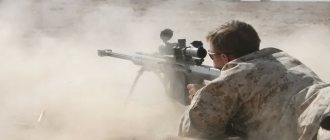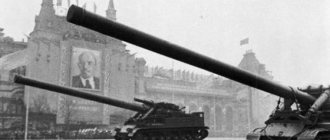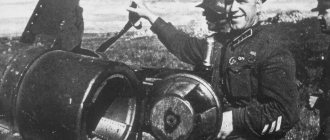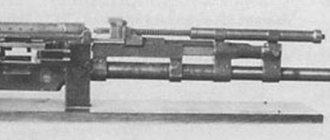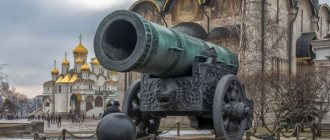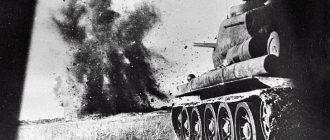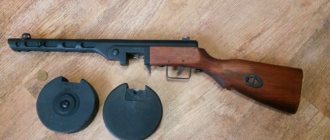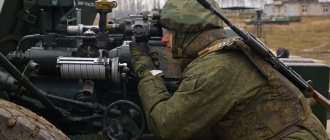The Age of Great Guns
In 1453, two significant events took place at opposite ends of Europe: the end of the Hundred Years' War between France and England (as well as the preceding pogrom inflicted by the Franco-Burgundian army on the English fortresses in Normandy and Guienne) and the fall of the capital of the Byzantine Empire - Constantinople. These events culminate the “Artillery Revolution,” which began around 1420. The “sudden” and complete failure of the old fortresses before the power of new siege weapons opens the “age of the great cannons,” lasting from approximately 1420 to 1520, when it is “closed” by new fortification systems.
The age of great guns begins
By the middle of the 15th century, Italy and Germany became the main centers of European arms production. Secondary centers are France, Flanders, Spain, Switzerland (however, Spain will have to wait another half century for a military-technical breakthrough). In terms of the development of artillery technology since the 14th century, all other countries have been ahead of the Italian city-republics. It was here that cast bronze tools and iron projectiles began to be systematically used. Here, in the mid-third quarter of the 15th century, the first attempts at physical and technical understanding of artillery issues were made (works by Taccola and Leonardo da Vinci).
From about the third quarter of the 15th century, the leading role of Italy in the development of artillery technology was “intercepted” by France. This is often considered to be the merit of the Bureau brothers, Jean and Gaspard (“chief commanders of the royal artillery” from 1439 and 1444, respectively), and with their participation, the allocation of artillery to a “arms of arms” during the military reforms of King Charles VII.
Bombard (or large kurto) and mortar. The siege of the fortress, as seen by a French or Flemish artist of the 1470s–1480s. Manuscript "Chronicles of England" by Jean Wavrin ("Recueil des croniques d'Engleterre"; Royal 14 E IV)
Mainly, however, France's successes should be attributed to the strengthening of central power - and at the same time the financial power of the state. The scale of resource use required by the new level of artillery technology was simply unsustainable for smaller or weaker government entities. The leading military-technical force in the Muslim world - comparable to European centers - at that time was the Ottoman Sultanate, and what was said about France fully applies to its successes.
Examples of successes of siege or siege artillery in the 2nd half of the 15th century are numerous, so we will list only the most famous or characteristic of them. We are talking about the successes of the Franco-Burgundian forces in the sieges of the 1450s. was already underway. Their “reflection” on the other side of Europe is the fall of Constantinople.
The so-called “Dardanelles cannon”, made by the Turks in 1464. Most likely, the design is very similar to the “Urban cannons” used in the siege of Constantinople in 1453.
During the siege of Constantinople in 1453, which had powerful fortifications with walls up to 12 m high and up to 7.5 m thick, the Ottoman army had numerous artillery and handguns. The famous 1200-pound "Hungarian Urban cannon" was included in the main 4-gun siege battery of the Ottoman army, installed against the gate of St. Roman. In addition, eight other large guns made up three more siege batteries. The largest of them fired 800-pound cannonballs, while the others fired much smaller ones: from 500-pound to less than 200-pound caliber. To make the cores, marble was used, which was taken from ancient Greek buildings.
Western historians are of the opinion that on the second day the “Urban gun” cracked, and on the 4th or 5th day of the bombardment, which began on April 12, it became completely unusable. It was then allegedly repaired by May 6 and used during the final assault on May 28. If all this is true, then it is more likely that the cannon was still of a traditional iron construction. However, a certain Nestor-Iskander, who saw the siege from the Turkish side, reports that a successful shot from the defenders damaged the gun. Then they repaired it and strengthened it with iron hoops, but without success. And only after some major repairs
“...[May 6] they hit with big guns, and a lot of stones fell. In others they hit, and the walls of a great place fell apart... [May 7] the Turks again hit with large cannons below that place, and knocked down a lot of walls; and so on in another and in a third.”
It is reported that Urban, it turns out, was not very experienced in directing the fire of siege artillery, and he was helped by the envoy of the removed Hungarian regent Janos Hunyadi with practical advice. Under fire from the siege batteries, eventually “the two walls and the tower between them, as well as the tower of St. Romano near the gate, fell to the ground, and the Turks saw the defenders inside, and they saw them.”
. The Turks had to shell the city for more than six weeks in a row, until the very last assault.
In 1456, in the penultimate siege of Belgrade, the Ottoman army again used many artillery pieces. This time the Turks failed to repeat the success of Constantinople. In this regard, the message of Dollecek is very interesting, who says that “the Turks are leading 12 [cast bronze] cannons with a barrel length of 5–6.5 m and a caliber of up to 1500 mm against Belgrade, but almost all of them explode.”
. It is likely that casting cannons from bronze, especially such large ones, is still a new thing, including for the Turks, and hopes for untested samples are not justified. Only in the 1480s. this technique is becoming, according to Dollecek, commonplace.
On the other hand, in the Belgrade Fortress back in 1432 there were “3 bombards made of bronze, two of them [have barrels] of two parts, and one is so large... 42 inches across where the stone goes [caliber approx. 1100 mm]"
.
According to an eyewitness, “it is too short”
- that is, most likely, this refers to the prototype of later mortars.
The iron bombards behind wooden covers roughly correspond to what could be seen during the siege in England in the second half of the 15th century. However, long-barreled handguns appear here only in about the last quarter of a century. Handwritten "Chronicles of England" by Jean Wavrin ("Recueil des croniques d'Engleterre")
In 1464, during the Wars of the Roses, after the Battle of Hexham, Sir Gray retreated to Bamburgh Castle, where he was besieged by the Duke of Warwick, the "kingmaker". The Duke's army carries with it two "huge bombards"
(
"cum maxemis bombardis"
), referred to as "London" and "Newcastle".
“Hitherto impregnable”
, Bamburgh Castle surrenders. The same guns were apparently used in the successful siege of Dunstanburgh in 1465.
The general military failures of the Duchy of Burgundy in the 1470s, indirectly related to artillery, seem to “cast a shadow” on the capabilities of Western European guns of that time. However, rather, they indicate a comparative lag in the tactics and equipment of other branches of the military.
The Siege of Orleans in 1429, as seen by a Flemish artist around 1490. In terms of the composition of the equipment, it may well relate to the Burgundian sieges. Shown is a long-barreled bronze bombard, a field gun and a long-barrelled hand grip
So, during the siege of Beauvais (1472), where, by the way, another Jeanne became famous - Jeanne of Leni, nicknamed Jeanne Hachette (Hatchet), - the Burgundians made a hole in the wall with the first shots. During the siege, “stones [cannonballs] fell everywhere, some in a circle as big as the bottom of a barrel, and others as big as a dish...”
.
During the Siege of Neuss (1474–1475), siege artillery "reduces the gates and walls of the city into ruins." However, both of these sieges were ultimately unsuccessful. In three unsuccessful battles of 1476–1477. (under Granson, Morat and Nancy) the Burgundians even “distributed guns”
to the Swiss. This indicates weak interaction between the military branches on the battlefield.
The siege by the Turks in 1480 of a fortress on the island of Rhodes, belonging to the knightly Order of the Hospitallers, ended in failure. Siege artillery ( "16 great cannons, each 22 feet long"
) destroyed several towers, walls and the palace of the Grand Master.
During the bombing, “the earth trembles under your feet
,” and the only safe place in the city is
“a cellar or a cave
. However, all assaults were repulsed and the siege was lifted. It is noteworthy that the German pilgrim who described the siege claimed that almost all the gunners in the Turkish army were Germans.
The Italian wars, which began with the conquest of the French king Charles VIII in 1494–1498, were already fought during siege artillery using iron cannonballs and field artillery on movable wheeled carriages. The sieges of Italian cities by the French army, in comparison with the final period of the Hundred Years' War, were the same as the sieges of the end of the Hundred Years' War were in comparison with the sieges of the beginning of the 15th century. Cities with powerful (according to old concepts) fortifications not only surrendered in a few days - many surrendered without a fight at all. Half a century later, the only Italian states of any military significance were Venice and Genoa.
Types and design of guns
By the middle of the 15th century, the main type of siege weapon was a bombard with an iron forged-welded barrel (French, English, Flemish and German lands) and, much less frequently, with a bronze cast barrel (Italian and probably Spanish lands, where large guns were “pawnshops”) " - came from Italy).
Bombard barrel from 1410–1420s. lengthened, although short-barreled bombards of “old proportions” (“mortar bombers” in our modern classifications) were also used. Moreover, the weight of a core of several hundred pounds became common. If in 1427 the city of Nuremberg purchased a 200-pound caliber bombard, then in 1434 the British threw in cannons, the largest of which were designed for a 330-pound caliber cannonball. In 1435, a bombard of approximately 700 pound caliber was made in Ghent. In 1457, the Scottish king received a bombard of approximately 330 pound caliber as a gift.
By the end of the 15th century, large forged-welded iron tools were replaced by cast bronze ones, and stone cores by cast iron ones. Thus, in Nuremberg (1445), master Hans von Rosen cast a bombard weighing 519 centners (up to 20 metric tons), decorated with the image of St. Sebald. In 1451, he cast the Luxembourg bombard in Luxembourg, which weighed 36 thousand pounds (up to 18 tons).
"a large cast [bronze] bombard" for the Duke of Burgundy in 1457–1458
weighing 33–34 thousand pounds of “metal” (up to 16 tons), firing stone cannonballs
“17 inches across
.
Perhaps they planned to use this weapon with an iron core. By the way, “behind the said bombard, so that it would be safer to shoot from it
,” a lead plate weighing 800 pounds was installed.
Monstrelet writes of a large bombard made by Jean Maug at Tours (1478), the iron core of which weighs 400 pounds. In 1477, by decree of Louis XI, “a dozen huge bombards were cast in bronze, firing
an iron cannonball of 500 pounds
.
In addition to bombards, siege artillery of that time included any smaller guns, but large enough to cause damage to fortifications. Common names for them are “cannon” or “big gun”, and also (large) “vogler”. In this order they are listed in sources of the mid-15th century: “...many large bombards, large cannons, voglers...”
.
By the last quarter of the 15th century, mortars themselves appeared, i.e. specialized guns with low muzzle velocity, capable of firing at very high elevation angles. These guns are finally replacing mortar bombards. Mortars have been mentioned in French sources since the 1460s. In Burgundian sources before 1485, mortars are rarely mentioned, mainly as a comparison (“the gun fires like a mortar”
). Mortars have been mentioned in German military manuals since the 1470s. However, they would become truly useful and widespread only in the 16th century, with the advent of an effective explosive projectile.
Around 1460–1470s. in France and Burgundy, and later in England, a type of large-caliber gun called “courtau” (French “courtau”, English “courtaw”) stands out. Courtaulds are capable of firing more frequently than bombards, both direct fire and overhead fire ( "over obstacles"
). That is, they are the prototype of howitzers. These smaller (and cheaper) bombard guns have combat mobility: they are mounted on a wheeled carriage. Curtos could be muzzle-loading or have a removable charging chamber.
For ease of transportation, the barrel of large bronze bombards (Italian, Turkish) could be made of two or even three parts, which were equipped with threaded connections. In this case, parts of the barrel had noticeable belts of square holes for inserting levers, which were used to rotate the parts during assembly and disassembly.
Any of the above-mentioned types of guns could have a removable charging chamber, if the size and weight allowed it at all. Larshey gives examples of charging chambers - archaeological finds weighing up to 1.5 tons. It is possible, however, that these are simply parts of finished tools, since even non-removable charging chambers could be made separately.
However, by the end of the century, the increase in the strength of gunpowder coupled with imperfect locking structures put an end - for three and a half centuries - to large breech-loading guns. Small “treasury charges” did not go out of use for much longer. The expression “breech loading” refers here only to a charge of gunpowder placed in a removable chamber. The wad (wooden pallet), and then the cannonball, were loaded from the muzzle, as in subsequent purely muzzle-loading designs.
Shells
The events of 1453 are the pinnacle of achievements of siege weapons that fire stone cannonballs. Rock artillery will never achieve anything as amazing as this again. It should be noted that the actual introduction of the stone projectile in the 1360–1380s. was a forced measure generated by the technical imperfections of the then gun barrels and gunpowder and, in parallel, the need to increase calibers.
The ratio of the densities of stone and cast iron can reach up to 1:3, so a stone core is up to 1.4 times larger in diameter than an iron core of equal weight. Accordingly, it loses speed faster. The strength of a stone core is about the same as that of an opposing stone wall, so a stone core can break. Making a stone core is difficult and difficult to perform: the wages of a stone cutter in England, as Oakeshott reports, in the 1380s. was "equal to the pay of a horse archer"
, and in 1399 it was compared with the payment of a mounted man-at-arms. In the 16th century, the cost of making stone shells increased even more.
On the other hand, a stone core of the same diameter as a metal one requires a smaller powder charge. This not only saves expensive gunpowder, but also allows you to make the walls of the gun thinner and the gun lighter. These features allowed stone-shot bombards to be used very successfully on Mediterranean military rowing ships at the end of the 16th century. The most advantageous battle tactic for them was to approach the enemy at close range and fire longitudinally at the enemy rowers from the bow guns. Under such conditions, large stone cores were in no way inferior to iron ones.
The stone core could be made from local raw materials, without the use of high-tech equipment. Not only Turkish, but also Burgundian siege weapons of the 15th century used marble. English artillery of the 16th century used balls made of Kentish gray limestone (“Kentish ragstone”).
In addition, the thin-walled weapon could use an analogue of buckshot, which made it useful in close combat. This allowed stone guns to linger in the role of anti-assault weapons and in combat formations in the 16th century. Back in the middle of the 16th century, the army of Charles V had breech-loading stone-firing cannons, and the stone-firing guns of the German army became trophies of Charles V in the Schmalkaldic War (1546–1547). English artillery of the 16th century used stone cannonballs. The names of these weapons in the 16th century directly meant “stone shooter, stone thrower”: fr. "perrier", Spanish "pedrero", German. "Steinbüchse" etc.
The Moscow “Tsar Cannon” (1586), designed specifically for firing “stone shot” - buckshot, was made at a time when Tatar attacks on Moscow were still real. Stone-fired weapons (cannons and mortars) remained in use at the end of the 18th century - in outlying fortifications and in the navy, most often in the breech-loading version. The arsenal of the Spanish fortress Castillo de San Marcos in America numbered 6 thousand stone shells in 1707. Mainusi gives an example of a 16-inch Spanish mortar from 1788, designed for mounted shooting with stone grapeshot. This weapon (and, apparently, similar ones too) has been around since the 1750s. could also fire "baskets of hand grenades".
From the 1470s, siege artillery, primarily French and Burgundian (German - closer to 1500, under Maximilian I), began the transition to an iron (cast iron) cast core. However, a reliable technique for casting cores for large iron cannons would not be developed until the 1540s.
For smaller (field) guns, with imperfect iron casting technology, composite cores were also used - an iron (less often stone) core in a lead shell. Such cannonballs were found in abundance on the island of Rhodes, and the Danish artillery used similar ones even in 1849. There are also references to bronze cores, although these are apparently out of the ordinary cases. Bronze is an expensive material, so it can only be used if there are “free resources” (as in the case of the plunder of cities by imperial and French troops in the Italian wars).
An incendiary projectile for relatively small guns in the 14th century was a fire (cannon) arrow. Since the 15th century, treatises on artillery often depict cannonballs emitting fire (that is, filled with an incendiary composition). It is unclear, however, whether this was actually carried out. An incendiary projectile - a red-hot cannonball, the invention of which is attributed either to Franz von Sickingen (1525) or to the Polish king Stefan Batory in the 3rd quarter of the 16th century, has been known since the Ghent siege of Udenar (1452) and is depicted in treatises of the 15th century.
The explosive shell (cannon bomb) with a cast iron casing was first used at the siege of Rouen in 1562. Its prototype with a body of two copper hemispheres was used by the Venetians already in 1376. Apparently, the same shells were used by the army of the Duke of Bavaria against the city of Regensburg in 1388. The army of the Duke of Rimini Malatesta used bronze shells filled with gunpowder in 1434. The shells, which consisted of an iron shell, which was tightly packed with gunpowder, were mentioned by the Greek historian of the mid-15th century, Doukas.
Anti-personnel shotgun shell in its “real” (specially made) form was used for the first time only in the last quarter of the 16th century (the naval battle of Lepanto and the siege of Ostend), but prototypes of buckshot (stone shot, various fragments and pieces of stone and metal) were used back in the 14th century century.
Carriage
In the 15th century, guns began to be mounted on wheeled carriages, and in the middle of the century, axles appeared - transverse axles attached to the barrel and simplifying vertical aiming. Siege weapons of the old design, i.e. with trunks without trunnions, of course, they still used fixed platforms made of beams, equipped with stops.
But the newly made great cannons with a stone core (and therefore having a particularly large caliber) had to be installed in the same way, since they were too heavy for wheeled carriages. Only a new generation of siege weapons designed for an iron core acquired mobility - the new “great cannons” in France, “royal cannons” in Spain, scarfmen in Germany, etc.
However, in the 1540s. Biringuccio lamented that the wheeled carriages were so cumbersome that the guns were barely able to move and slowed down the movement of the troops. As Devries and Smith believe, the low mobility of guns during a campaign is still exaggerated. The armies themselves of that time moved no faster than large guns, that is, marches of the order of 12–20 km per day (figures for an army of 10–20 thousand people).
Proper names
Large guns in the 15th century, as a rule, received proper names, and the most bizarre ones at that. In addition to female names, there were often names based on “place of birth or residence,” names of fabulous, outlandish and frightening creatures, and even just random or funny names. But the names also had a very practical meaning - in the era of the absence of standards, they helped to distinguish between shells and charges for certain guns in the convoy.
Samples
Even the “great cannons” became too numerous in the second half of the 15th century to list them all. The following are brief descriptions of the most representative or well-known examples.
"Faule Magdt von Dresden"
German (Saxon) “faule Magd” of the 1st half of the 15th century. The carriage was made much later
Bombard made in Saxony in the 1st half of the 15th century. The exact year of construction is unknown, but some design features (for example, a relatively voluminous charging chamber) indicate the interval between 1430–1450.
Iron barrel with a caliber of 34.5 cm, muzzle-loading, forged-welded design (20 longitudinal bars and 46 hoops, less often attached to the barrel). The barrel length is 2.33 m (including the charging chamber 0.81 m) and the weight is 1.32 tons. The estimated weight of the stone core is about 50 kg.
An example of German “ordinary” great cannons from the mid-15th century.
"Dulle Griet von Gent"
Flemish "dulle Griet" (c. 1435). Iron tools were painted bright red in the 15th century to protect them from rust, as well as for style.
The bombard “Mad Greta (Margarita) of Ghent” was made in Flanders (1435) and named after the character of Dutch folklore - “a woman-boy who goes to hell and causes a scandal there”
(sometimes it is said that the name was given supposedly in memory of the cruel Margaret of Flemish, who lived in the 13th century).
Iron barrel with a caliber of 64 cm, muzzle-loading, forged-welded design (32 longitudinal beams and 61 hoops). Trunk length 5 m, weight 16.4 tons. Stone core weight approx. 320 kg.
The gun was used in battle only once, during the siege of the city of Udenar by the Ghent army (1451/1452); After the failure of the siege and the hasty retreat of the Ghent people, the gun fell into the hands of the Udenarians and was returned to Ghent only in 1578.
The largest surviving European bombard of forged-welded construction, but by no means the largest ever made.
"Mons Meg"
Flemish "Mons Meg" (1449). Decorative carriage
Bombard Meg (Marguerite) from Mons was made by order of the Burgundian Duke Philip the Good in Flanders (1449) and presented to the Scottish king James II (1457). Studying it in the 1980s. made it possible to re-evaluate the capabilities of forged-welded technology of the mid-15th century.
Iron barrel with a caliber of 48–50 cm, muzzle-loading, forged-welded design (25 longitudinal bars and 36 hoops). The charging chamber is made separately and tightly screwed to the barrel. Trunk length 4 m, weight 5.8 tons. Stone core weight approx. 150 kg.
The weapon was used in the sieges of the castles of Dumberton (1489), Thrieve (1497) and Norham (1497). In 1682, in Edinburgh, it exploded during a salute in honor of the Duke of York (later King James II of England), nearly injuring the Duke himself. The decorative two-wheeled carriage was replaced in the 20th century by the decorative four-wheeled one on which the gun is mounted today.
An example of large Flemish/Burgundian bombards from the mid-15th century.
"Basel gun"
Basel gun (left) and courteau (right)
This bombard is conventionally called “Basel” after the museum in which it is exhibited. Made according to a Burgundian order, apparently in Flanders around 1450. Captured by the Swiss in 1476 (part of the "Burgundian booty").
Iron barrel with a caliber of 34.5–36 cm, muzzle-loading, forged-welded design (20 longitudinal bars and 34 hoops). The estimated weight of the stone core is 98 pounds.
An example of “ordinary” Flemish/Burgundian bombards from the mid-15th century.
Constantinople bombard
The famous cannon, made by order of the Ottoman Sultan Mehmed II in 1453 for the siege of Constantinople, is known only from descriptions of contemporaries, including eyewitnesses of the siege - the Byzantine historians Doukas and Chalkokondyles. It is known that it was made by the master Urban, who came either from Hungarian, or from Dacian (Greek: “∆αξ”), or even from German lands. Although he created other guns, this is the one usually associated with his name (“Urban’s gun”).
The barrel is generally considered to be cast bronze, consisting of two parts that are screwed together when installed in position. The length of the assembled trunk is “40 spans”
(at least 8 m), the weight of the marble cores is
“1200 pounds”
and their size is
“11–12 spans in circumference”
; the caliber is therefore at least 70 cm; most likely ok. 75–80 cm. Firing range of at least 1 km. The rate of fire is 4 shots per day (sometimes they say 7 shots per day).
Dardanelles gun
Dardanelles gun today
A bombard made in 1464 (or 1467) for the Ottoman Sultan and presented to the Queen of England in 1866.
The barrel is bronze, cast, and consists of two parts. Caliber 63 cm, length 5.18 m and weight 16.8 tons. The estimated weight for marble cores is at least 290 kg.
The only surviving example of these pores and the place of manufacture. The cannon is on display at Fort Nelson near Portsmouth. It is assumed that it is of the same type as the bombards of the Constantinople and Belgrade sieges. Given the time of manufacture and the numerous explosions of those guns, it is possible that this gun is of an improved design.
"Tsar Cannon"
The famous weapon cast from bronze by master Chokhov (Chekhov) in Moscow (1586); installed in the Kremlin. At first it was called "Shotgun". The name “Tsar Cannon” came into use between 1810 (History by Karamzin) and 1865 (works by Khmyrov).
The barrel is bronze, cast, relatively thin-walled. Caliber 89 cm, length 5.4 m ( "2 fathoms 3 feet 9 inches"
), mass of St.
39 t ( "2400 poods"
). The projectile, judging by the name, is a charge of “shot”, stone buckshot.
Before the “Shotgun,” there already existed the “huge “Tsar Cannon” (also known as the “Debosis Cannon”), cast in Moscow in 1488 by the invited master “Fryazin [Italian] Pavel Debosis.” From it in 1584, “in the first days of the reign of Fyodor Ivanovich,” Muscovites who rebelled against the “hated boyar Belsky” intended to shoot at the locked Spassky (or Florovsky) gates of the Kremlin.
.
Apparently, it was precisely these “two huge cannons” in the early 1590s. “were lying on Red Square,” as Karamzin reports.
Despite the time of construction, Chokhov's Tsar Cannon demonstrates the concepts and design of the 2nd half of the 15th century. The combat value is unclear, but the demonstrative value is undeniable - including as an example of mastering the technique of casting super-large products.
Courtauld
Courtaulds are mentioned in the sources for a relatively short period of time and are not clearly defined in them. Of the surviving examples, Smith and Devries refer to the courtauld bronze cannon in the Basel Museum, which originated from the "Burgundian booty" of the Swiss.
"Burgunderin" cannon in the arsenals of Maximilian I around 1500–1510. Perhaps it was precisely such a weapon that contemporaries called “curto”, like the bronze barrel in the Basel Museum
The weapon in question was made in 1474 by Jean de Malin (Johann of Mechelen) for the Duke of Burgundy. It was captured by the Swiss in 1476 under Granson, and is now on display in the Basel Museum. A gun called "Burgunderin", almost identical to this one and mounted on a wheeled carriage, is depicted in the inventory of the workshops of Maximilian I.
The barrel is bronze, cast, caliber 22.7 cm (barrel length is about 7 calibers), with two trunnions. Barrel length 2.55 m, weight 1956 pounds (up to 1 ton). 85 lb. core (in the case of an iron core. "Burgunderin" in the illustration is shown with stone cores).
It is also possible that this weapon is a transitional type from the bombard or great cannon of the 15th century to large siege weapons with an iron core of the 16th century such as the scarfmetz and the like. In this case, the example is also notable for having only two trunnions on a large 15th-century weapon.
Sources from the 1470s they talk about the court in the artillery park of Karl the Bold as guns with a charging chamber, a barrel “4½ feet long”, on a wheeled carriage.
Literature and sources
- Karamzin N. M. History of the Russian State. T. 10.
- Contamine F. War in the Middle Ages. St. Petersburg, 2001.
- The story of Constantinople (its founding and capture by the Turks in 1453) by Nestor-Iskander of the 15th century. (According to the manuscript of the Trinity-Sergius Lavra of the early 16th century, No. 773). St. Petersburg, 1886.
- Runciman S. The Fall of Constantinople in 1453. M., 1983.
- Khmyrov M.D. Artillery and gunners in pre-Petrine Rus'. (Historical and characteristic essay). St. Petersburg, 1865.
- Gaier C. Le commerce des armes en Europe au XVe siècle // Armi e cultura nel Bresciano 1420–1870. Brescia, 1981, pp. 156–168.
- Angelucci A. Le bombarde. Nota storico-illustrativa A // Documenti inediti per la storia delle armi da fuoco Italiane. Raccolti, annotati e pubblicati da Angelo Angelucci, Capitano d'Artiglieria. Volume I. Parte I. Torino, 1869. P. 65–101.
- Baarmann. Die “Faule Magd” der Königlichen Arsenalsammlung zu Dresden // Z. Hist. Waffenkunde. 1906–1908. Bd. 4. S. 229–235.
- Bedford WKR The First Siege of Rhodes, 1480 // Royal United Services Institution. Journal. 1899. Vol. 43, Issue 251, pp. 42–52.
- Brackenbury H. Ancient cannon in Europe. Part II. From AD 1351 to AD 1400. Woolwich, 1866. URL: books.google.com/books?id=KwgHAAAAQAAJ.
- Coltman Clephan R. The Ordnance of the Fourteenth and Fifteenth Centuries // Archaeological Journal. 1911. Vol. 68, no. 1. P. 49–138.
- Delbrück H. Geschichte der Kriegskunst im Rahmen der politischen Geschichte. Vierter Teil: Neuzeit, Berlin: Georg Stilke, 1920 (Nachdruck Berlin: Walter de Gruyter, 1962).
- DeVries K., Smith R.D. Medieval weapons: an illustrated history of their impact. ABC-CLIO, 2007.
- Dolleczek A. Geschichte der österreichischen Artillerie von den frühesten Zeiten bis zur Gegenwart. Wien, 1887.
- Doukas. Decline and fall of Byzantium to the Ottoman Turks. Wayne State University, 1975, pp. 305–306.
- Ellger, K. von. Die Kriegsfeuerwaffen der Gegenwart Ihr Entstehen und ihr Einfluss auf die Taktik der Infanterie, Artillerie und Reiterei. Leipzig, 1868. URL: archive.org/details/bub_gb_T6M6AAAAcAAJ.
- Gay V. Glossaire archéologique du Moyen Age et de la Renaissance. T. 1. Paris, 1887.
- Geßler EA Beiträge zum altschweizerischen Geschützwesen. Die großen Geschütze aus dem Zeughausbestand der Stadt Basel // Z. Hist. Waffenkunde. 1914. Bd. 6. S. 3–12, 50–61.
- Guilmartin JF The weapons of sixteenth century warfare at sea // Gunpowder and galleys: changing technology and Mediterranean warfare at sea in the sixteenth century. Rev. ed. United States Naval Institute, 2003.
- Henne am Rhyn O. Kulturgeschichte des deutschen Volkes. Teil 2. Berlin, 1886.
- Jähns M. Entwicklungsgeschichte der alten Trutzwaffen mit einem Anhange über die Feuerwaffen. Berlin, 1899.
- Kelly J. Gunpowder, alchemy, bombards, and pyrotechnics: the history of the explosive that changed the world. New York, 2004
- Larchey L. Origins de l'artillerie française. Planches autographiées d'après les monuments du XIVe et du XVe siècle, avec […]. Paris, 1863.
- Manucy A. Artillery through the ages: a short illustrated history of cannon, emphasizing types used in America. Washington, 1985.
- Partington JR A History of Greek Fire and Gunpowder. JHU Press, 1999.
- Promis C. Dello stato dell'artiglieria circa l'anno millecinquecento… Memoria storica II // Trattato di architettura civile e militare di Francesco di Giorgio Martini, architetto senese del secolo XV (1841). P. 121–199.
- Smith RD, DeVries K. The artillery of the Dukes of Burgundy, 1363–1477. Boydell Press, 2005.
- Sterzel H. Die “Dulle Griet” von Gent // Z. Hist. Waffenkunde. 1915–1917. Bd. 7. S. 324–325.
- Würdinger J. Kriegsgeschichte von Bayern, Franken, Palestine und Schwaben von 1347 bis 1506. Band II. Kriegsgeschichte und Kriegswesen von 1458–1506. Munich, 1868.
- Zeugbuch Kaiser Maximilians I. . Innsbruck, [1500–1510].
Story
The cannon may have originated as early as the 12th century in China and was likely a parallel development or evolution of the firearm, a short, long-range anti-personnel weapon combining a gunpowder-filled tube and something like a spear. Early projectiles such as iron scraps or porcelain shards were once placed in the cavities of long bamboo spears, but paper and bamboo barrels were eventually replaced by metal. The ancient Chinese clearly had no idea what a cannon was in the usual sense of the word.
Approaching the Renaissance
The Battle of Crécy, which took place between the English and French in 1346, recorded the early use of cannon to help fight off a large force of crossbowmen deployed by the French. The British originally intended to use the massive gunpowder cannon against cavalry, moving their archers further away, believing that the loud noises made by the cannons would spook the oncoming horses and kill the riders mounted on them.
Early models of artillery could be used not only to kill infantry and scare off horses, but also for defense. The English cannon was used as a defensive weapon during the siege of Breteuil Castle, when the English fought off the advancing French. Thus, the cannon could be used to destroy siege equipment before it reached the fortifications. Firing from a cannon was probably already carried out at that time for siege purposes, because in this way it was possible not only to break fortifications, but also to set them on fire. The special igniter used in these guns was most likely a special powder mixture.
Another aspect of early European artillery is that they were fairly small, compact bombards, which nevertheless moved quite slowly and were the last to reach the battlefield. In fact, it is likely that the cannon used at the Battle of Crécy was capable of moving quite quickly, as there is an anonymous chronicle that notes that the weapon was used to attack the French camp, indicating that it was mobile enough to Attack. These dwarf cannons eventually gave way to larger wall-breaking cannons that appeared throughout Europe by the late 1300s.
T-14 - king of the battlefield
The artillerymen clarify that the multi-purpose tanks currently serving in the Russian Armed Forces are armed with either the usual 125-mm 2A46 cannon (and its modifications) or the 2A82, which was precisely intended for the re-equipment of the T-72, T-80 and T-90 tank fleet with minor modifications to the fighting compartments. In addition, the T-14 on the Armata platform can be added to the list of tanks equipped with a 125 mm gun. Its turret contains 2A82 modifications 1M.
© oruzhie.info The Russian 2A82-1M smoothbore gun is installed on T-14 Armata tanks.
Reference
The weight of the 2A82-1M gun is 2,700 kg, the barrel length is 7,000 mm. Muzzle energy of the shot is 15-24 MJ. The initial flight speed of the projectile is more than 2,000 m/s. The effective firing range of projectiles is 4,700 m, the 3UBK21 Sprinter guided missile (URS) is 8,000 m, the Reflex-M anti-tank guided missile (ATGM) is 5,500 m. The gun's rate of fire is 10-12 rounds per minute. Armor penetration with an armor-piercing sabot projectile (APP) is 850-1,000 mm, ATGM - 950 mm. The life of the gun barrel is 800-900 shots. Ammunition - 45 shells. Automatic loader - 32 rounds.
In general, the 2A82-1M is a modern weapon, in terms of basic performance characteristics it is at the level of foreign models, and in some indicators it surpasses them. It makes the T-14 the king of the battlefield. Meanwhile, the designers of this tank also provided for the installation of a 152-mm 2A83 cannon. Apparently, Salyukov meant exactly this.
Reference
According to data from open sources, the smooth-bore 2A83 has a mass of more than 5 tons, a barrel length of 7,200 mm, and an initial projectile speed of 1,980 m/s. The muzzle energy of the shot is 20-25 MJ. The effective firing range is 5,100 m, the Krasnopol URS (in various modifications) is from 12 to 20 km. The gun's rate of fire is 10-15 rounds per minute. Armor penetration of BPS - 1.024 mm, ATGM - 1.200-1.400 mm. The life of the gun barrel is 280 shots. Ammunition - 40 shells. Automatic loader - 24 rounds.
New is good, but old is not completely improved
It is easy to see that the 2A83, in comparison with the 2A82-1M, has a number of advantages. I would especially like to emphasize that the 2A83 has the ability to fire ammunition up to one meter in length, such as the Krasnopol, which is fired, for example, by the Msta-S self-propelled gun.
But this weapon also has a number of disadvantages. One of them is the large mass of the gun (and the resulting reduced ammunition load). Another drawback is a significantly shorter service life compared to the 2A82-1M. However, according to experts, the problem of ammunition can be solved by placing additional shells in the turret niche.
There is an opinion that the range of ammunition for the 2A83 will be expanded to include depleted uranium sub-caliber projectiles, which Rosatom specialists are working on.
© oruzhie.info
A version of the T-14 tank with a 152 mm cannon will probably be put into production.
In continental Europe
In Europe there is a record of firearms dating back to 1322, discovered in the nineteenth century but lost for unknown reasons. Fortunately, even in photographs, guns from different centuries can easily be distinguished from each other depending on their “age.”
The earliest known European depiction of this weapon appeared in 1326 in a manuscript by Walter de Milemet, although not necessarily written by him, known as De Nobilitatibus, sapientii et prudentiis regum ("On the Greatness, Wisdom and Prudence of Kings"). This manuscript can be considered the beginning of the history of the cannon in Europe, for it describes a weapon with a large barrel, cannonballs and a long cane designed to push these same cannonballs. A document from a suburb of Turin, dated 1327, records a certain sum paid for the manufacture of a certain apparatus or device invented by Friar Marcello for throwing "lead pellets."
In turn, a record dated 1331 describes an attack organized by two German knights against the ruler of the city of Friuli. During this attack they used some kind of weapon whose power was based on gunpowder. The 1320s appears to have been the high point for the first firearms in Europe, as most European medieval historians agree. However, some scholars suggest that the absence of gunpowder weapons in the well-stocked Venetian catalog for the new crusade in 1321 means that the Europeans did not yet know how to fire a cannon - and, in general, did not yet know what it was such. We can only hope that in the future archeology will provide us with more data to finally resolve this issue.
In the Balkans
The later large cannons were known as bombards and ranged in length from three to five feet. They were used by the Croatian cities of Dubrovnik and Kotor for defense already at the end of the 14th century. The first bombards were made of iron, but bronze became more common as it was found to be more stable and capable of propelling stones weighing up to 45 kilograms (99 lb).
Around the same period, the Byzantine Empire began building its own cannons to counter the Ottoman Empire, starting with medium-sized 3-foot (0.91 m) long 10-gauge guns. The earliest reliable mention of the use of artillery in the Balkans dates back to 1396, when the Byzantines forced the Turks to leave by firing at them from the walls of Constantinople, which was besieged by the infidels. However, the Turks learned to build their own guns and again besieged the Byzantine capital in 1422. By 1453, the Ottomans used 68 captured Hungarian guns for a 55-day bombardment of the walls of Constantinople, killing anyone who stood in their way. The largest of their guns was the Great Turkish Bombardier, which required a task force of 200 men and 70 oxen to operate, as well as at least 10,000 men to transport the bronze hulk. Gunpowder made the previously destructive Greek fire obsolete, and the Byzantines surrendered Constantinople in disgrace, losing their empire forever.
Near East
According to historian Ahmad Y. al-Hasan, during the Battle of Ain Jalut in 1260, the Mamluks used cannons against the Mongols. He claims that it was "the first cannon in history" and used a gunpowder formula almost identical to the perfect recipe for explosive powder. He also claims that this “superweapon” was unknown to either the Chinese or Europeans. Hassan further argues that the earliest textual evidence for this type of weapon comes from the Middle East, based on earlier originals that report the hand cannon being used by the Mamluks at the Battle of Ain Jalut in 1260. However, Hassan's claims have been refuted by other historians such as David Ayalon, Iqtidar Alam Khan, Joseph Needham, Tonio Andrade and Gabor Agoston. Khan claims that it was the Mongols who introduced gunpowder to the Islamic world, and believes that the Egyptian Mamluks developed guns in the 1370s. According to Needham, the term midfa, dated to textual sources from 1342 to 1352, did not refer to true hand cannon or bombards, and stories of iron cannon in the Islamic world are not recorded until 1365. Andrade dates the textual description of the cannon in Near Eastern sources to before the 1360s. Gabor Agoston and David Ayalon believe that the Mamluks were certainly using siege cannons by the 1360s, but the earlier use of these weapons in the Islamic world is unclear. There is some circumstantial evidence for the introduction of gunpowder weapons into the Emirate of Granada by the 1320s and 1330s, but the arguments put forward in support of this version are not very convincing from an academic point of view.
Ibn Khaldun reported the use of cannons as siege engines by Sultan Marini Abu Yaqub Yusuf during the siege of Sijilmas in 1274. Ibn Khaldun's campaign at the siege of Sijalmassa in 1274 is described in several sources, all of which contain references to massive iron cannons that, when fired, made a frightening rumbling sound, “terrifying Allah himself.” However, these sources do not correspond to the stated time and were written a century later, around 1382, and therefore most likely distort the real facts. This version has consequently been rejected as an anachronism by most academic historians, who are wary of claims about the use of Islamic firearms in the period 1204–1324, since later medieval Arabic texts used the same word for gunpowder and earlier incendiary mixture . The historian Needham, for example, believes that Ibn Khaldun in his descriptions had in mind ordinary burning spears, forges and catapults, which were perceived by later readers and interpreters as descriptions of cannons.
Ancient weapons
The oldest cannon in Europe is a small bronze barrel found at Loshul, Scania, in southern Sweden. It dates from the early mid-14th century and is currently housed in the Swedish Historical Museum in Stockholm. Photos of the cannon in the museum are available to anyone who is interested in the history of weapons, but who cannot afford to travel to Stockholm.
But not only the Swedes were noted for their weapon ingenuity. The performance of a cannon produced in 13th-century France certainly leaves much to be desired, but at that time Gallic guns were very popular throughout Europe. At that time, these tools were known under the French names pot-de-fer and tonnoire, as well as the German ribaldis and büzzenpyle. Ribaldis, who fired large arrows and simplified cannonballs, was first mentioned in the reports of the English privy ambassador during the preparations for the Battle of Crecy, between 1345 and 1346. Subsequently, traces of this German cannon are lost, and the word “ribaldis” quickly fell out of use.
In Great Britain
Outside China, the earliest texts to mention gunpowder are Roger Bacon's Opus Majus (1267) and Opus Tertium. The latter text, however, is interpreted as describing the first fireworks introduced to Europe. In the early 20th century, a British artillery officer suggested that another work tentatively attributed to Bacon, A Comparative Description of Heavy Guns, also known as the Opus Minor (i.e., "small work"), dated 1247, contained an encrypted formula for gunpowder hidden in the text. These claims, however, have been disputed by academic historians, so it is not known for certain whether Bacon knew what a cannon was. In any case, the very formula specified by the renowned scientist is useless for creating firearms or even fireworks: such gunpowder burns slowly and produces mainly smoke.
